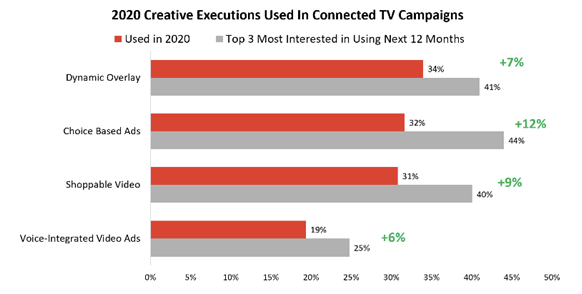As the industry is hurdling into a new era of privacy, the need for a next-level consumer ad experience that drives relevance and utility is more important than ever before.
By: Nina Muñoz
Not too long ago, I was having dinner with my 5- and 7-year-old nephews. With their roaming and curious minds, you never know where the conversation might go but to my surprise, they were excited to tell me about a CTV commercial they saw with their family at home. The ad was for a popular theme park, and they were given the option to select a specific aspect of the vacation experience in the park. As they were sharing the excitement of the ability to choose their own adventure in the ad, it struck me that I was hearing out of the “mouths of babes” why CTV represents an extraordinary opportunity to create a better advertising experience – one that is relevant with a compelling story that matters to the specific household and even allows the consumer to take action in a way that is non-intrusive and fosters a closer relationship with the brand. I share this story because it points to what I believe is true. Consumers do not hate advertising. They hate bad advertising.
There is plenty to be excited about for the streaming future of television. Almost 83% of households now own a connected TV and the banquet of quality content drove 30 billion minutes of streaming in Q1 2021 — which is up 122% from Q1 2018 where consumers watched 13.5 billion minutes. ¹ If we do not get the consumer ad experience right, this upward trajectory for CTV could be stifled. That is one of the biggest questions today—how can we provide the best possible ad experience to support this growth moving forward? The good news is that connected TV provides an entirely new canvas for marketers with new content capabilities, creative formats, and audiences with new expectations. The more concerning news is that as personalization becomes increasingly challenged in a more privacy-focused era, the need for creative that performs, scales and is privacy compliant across platforms has never been more important. The industry has the opportunity to abandon legacy approaches and reinvent the medium by putting the consumer and the creative ad experience at the center.
One way the industry is looking at up-leveling the CTV ad experience is by leveraging creative innovation to facilitate more engaging connections with consumers that drive entertainment as well as utility. Danielle Brown, SVP, Data Enablement and Category Strategy, Disney Advertising Sales stated, “Consumers will no longer accept a bad experience. The future of CTV advertising will more heavily leverage non-intrusive innovative ad formats. Consumers continue to want choice and storytelling, and to deliver on this, Disney is enabling a myriad of solutions such as the ability to choose to watch longer form brand content, learn more about products that interest consumers and deliver sequential messaging to create a unique ad experience across our platforms.” Kevin Lappen SVP, Peacock Sales, NBCU echoed that sentiment, “These innovative CTV ad formats aren’t just being discussed as custom one-offs. These formats are being discussed as part of our Upfront efforts this year and we expect that trend to continue in the years to come.”
 However, the industry agrees that we do not need an infinite number of innovative ad formats to select. Rather, to scale, publishers and advertisers need to adopt a handful of innovative and effective CTV ad formats that leverage existing technologies to become more turnkey and scalable. In IAB’s recent Video Ad Spend Study (released in May 2021), advertisers expressed interest and enthusiasm in investing in the following CTV ad formats: dynamic overlays, choice-based ads, shoppable ads, and voice integrated ads. In additional IAB member interviews, leveraging creative extensions/end cards and sequential CTV creative emerged as other important CTV creative tactics. The formats are defined as:
However, the industry agrees that we do not need an infinite number of innovative ad formats to select. Rather, to scale, publishers and advertisers need to adopt a handful of innovative and effective CTV ad formats that leverage existing technologies to become more turnkey and scalable. In IAB’s recent Video Ad Spend Study (released in May 2021), advertisers expressed interest and enthusiasm in investing in the following CTV ad formats: dynamic overlays, choice-based ads, shoppable ads, and voice integrated ads. In additional IAB member interviews, leveraging creative extensions/end cards and sequential CTV creative emerged as other important CTV creative tactics. The formats are defined as:
- Dynamic Overlay: Marketers can take existing video creative and use data to add an overlay that is personalized to the viewer.
- Choice Based Ads: Allows the user to control the ad experience by choosing the ad they want to see.
- Shoppable and Actionable Video: Interactive ads designed to connect consumers with products, services, or merchants within the ad itself. The ads can provide product learning and exploration, links to additional information, and could enable click-to-buy capabilities within the ad unit itself.
- Voice-Integrated Video Ads: Allows audiences to use their voice to interact with a brand by following on-screen prompts to speak into their remote.
- Sequential CTV Creative: Allows marketers to tell a story that unfolds across several CTV creatives, instead of trying to tell a story within a single ad.
- Creative Extensions & End Cards: Short-form content that is displayed before or at the end of an existing CTV creative.
This is why IAB, in partnership with contributing members, created the “CTV Creative Best Practices” guide. Our goal, along with highlighting creative innovation, is to educate publishers, agencies, and marketers on how to create the best possible consumer ad experience in CTV. A good consumer ad experience ultimately helps the whole ecosystem. It gives publishers the runway to better monetize their content and marketers/agencies the ability to reach their audiences and achieve their campaign goals. This guide identifies overall best practices for the CTV consumer ad experience, highlights the innovative CTV ad formats the industry is leaning into, and shares creative examples that showcase marketers’ success with those formats (creative examples). We also share insights from industry interviews conducted by the IAB Media Center that highlight where the industry needs to focus in the future to ensure we aren’t repeating mistakes of the past.
Below are eight key tips and advice for creating an optimal consumer CTV ad experience. To read the full guide, click here.
- Reduced and sustainable CTV ad loads are important to the consumer experience but must be balanced with other components of the ad experience like delivering the right creative with the right resolution that’s matched to the viewer’s screen size, improving reach and frequency management, etc.
In long-form content, the industry shouldn’t solely focus on serving less ads to improve overall viewing experience. They should also be thinking about how to make those ads less intrusive. – David Dworin, VP, Advisory Services And Trust, FreeWheel
- Creating multiple creative variants helps avoid creative burnout and is important for effective storytelling. With the help of publisher and ad tech partners, multivariant CTV creative does not need to be cost prohibitive.
- Frequency Control: While overall frequency certainly matters at the campaign level, it is critical to ensure the same creative is not repeated back-to-back in the same pod or delivered in the exact same position in an ad pod that is later in a program (for example, in the first position of every mid-roll break of a full episode.)
- Get on board with the latest technical video ad serving standards: To avoid latency and buffering, it is critical to get the basics of video ad serving right (with guidelines like IAB’s Digital Video In-Stream Ad Format Guidelines and VAST 4.x which support the highest quality CTV ad experience) before you move on to more advanced ad innovations.
If everyone in the industry was following IAB video guidelines, the number of problems we see in executing video campaigns would greatly decrease. Getting the basics of video ad serving right is crucial for the consumer ad experience. – Jarred Wilichinsky, SVP, Global Ad Monetization and Operations, ViacomCBS
- Leverage standard creative ad registries like Ad-ID (support for which is built into VAST 4.x) to enable better creative asset management, ad frequency, and better tracking/reporting.
- CTV ads can be interactive (but do not think of it like display):Interactive ads on CTV leverage a different engagement model than other platforms. They may use the user’s remote to serve up additional product information or image galleries. Voice activation may also be available to activate calls-to-action that enable product information requests or purchase direct from the screen. Be sure to include specific calls to action to educate and direct consumers.
- Shoppable QR Codes: We saw during the pandemic how restaurants leveraged QR codes for menu viewing. The same mobile scanning technology can be used to bring the store to CTV screens — enabling purchase directly from CTV ads. Make it easy for consumers to use the QR codes by ensuring the code is large enough to scan from the couch and visible for the duration of the ad.
- Experiment (but within reason): It’s important to test and learn which creative innovations work best to reach and engage with your specific audience while supporting your defined KPIs. However, don’t overuse capabilities as that can be counterproductive to engagement goals.
The creative pallet in CTV is continually evolving. Be sure to visit IAB.com for future updates, research, standards, and best practices. If you have thoughts on this document/CTV creative or would like to get involved further, please reach out to [email protected].
¹Source: eMarketer, Feb 2021 & Nielsen, June 2021
CTV Creative Best Practices Guide




